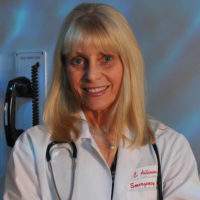Scholarships help the next generation
Help future doctors to reach for their dreams with a gift to scholarships.
GIVE NOW >Serving MD, MD/PhD, Res., Fel., PhD, PA-C (MEDEX), MA, MS, BS, PT, OT and P&O alumni, your UW School of Medicine Alumni Association is the place to connect with your classmates, your School and the next generation of medical professionals.

850 Republican Street, C-5
Seattle, WA 98195-8045

When Cheryl Adkinson, MD ’79, finished medical school and a residency in emergency medicine, she felt prepared for anything, and a little restless. This feeling would propel her around the world — from Saudi Arabia to Minnesota to Liberia to Haiti — resulting in a long career and many stories.
Uniquely qualified
Soon after earning a medical degree at UW School of Medicine and then completing an internship and residency at Hennepin County Medical Center in Minneapolis, Adkinson applied for a job to help modernize a hospital emergency department in Saudi Arabia.
Despite being warned that she may not like the job, Adkinson took it. For the next year and a half, she worked alongside Arab doctors from Egypt, Lebanon and Syria, an experience she describes as “fun, hectic, demanding, frustrating and eye-opening.”
What she did not realize was how prepared for the experience she actually was. As a medical student, she spent time in rural Alaska as part of her WWAMI experience — the UW School of Medicine’s five-state regional education program.
“In Alaska you don’t always have specialists available and you don’t always have what you need,” says Adkinson. She had to learn to be flexible, adaptable and resourceful — skills that would help her practice medicine in all kinds of environments.
For instance, she recalls one night in the emergency department in Saudi Arabia when a man arrived comatose, needing a CT scan of his head. The hospital had a CT scanner, but no one knew how to operate it. No one was trained to transport patients, so after the patient was stabilized, Adkinson traveled with him 20 miles to the nearest hospital where he could get the care he needed.
And there was another way in which Adkinson found she was unusually prepared. Unlike most doctors, she has a background in the social sciences, which has helped her connect with people, despite language and cultural differences.
She realized, for example, that when she initiated the medical history in Arabic, many patients would respond in perfect English. “You always try to do what you can to meet someone on their own terms, if possible, in their own language,” she says.
After returning to the U.S., Adkinson joined the emergency medicine faculty at Hennepin County Medical Center, where she spent the next 30 years practicing and teaching emergency medicine and subspecializing in diving and hyperbaric medicine. Altogether, she says, it was stimulating, consuming and rewarding work. Upon retirement, however, her restlessness returned.
Do what you can
Just a few months after leaving Hennepin, Adkinson found herself in rural Liberia, during the peak of the Ebola epidemic.
“I was in a good position to help contain this devastating disease — perfect skill set, no job obligations, no dependents, no plan,” says Adkinson.
However, the Ebola treatment unit where she was to work had not yet been built, which is why she was assigned to a 90-bed, understaffed, under-resourced county hospital outside the small village of Fish Town. As the only doctor on site, she began to wonder whether she would be able to make any kind of meaningful difference in a hospital where patients often died from treatable conditions due to lack of medications, supplies or surgery.
Then she met someone who changed her perspective. He was a young man with burns so severe, in such risky locations, that Adkinson doubted whether he would survive. “All we had was a little soap, Tylenol and one package of gauze bandages. I ended up using mosquito netting to cover his wounds,” she says.
After a frank discussion, they made an agreement. He wanted to live, despite the odds. Adkinson would do everything she could, and he would have to protect his wounds from contamination as much as possible and endure terrible pain as she cleaned his wounds without any anesthetic. They did their best, and by the time Adkinson left, two months later, he was nearly healed.
“I learned in an extreme situation it is enough to help one person. If you can’t do more, at least do that,” says Adkinson. She admits that her experiences abroad have been full of surprises and learning opportunities, and she has gained a new appreciation for the fragility of life and the courage she has seen her patients display in the face of adversity.
Now, she is searching for her next project. “The only problem with such a fortunate career, as I see it, is that it is a hard act to follow,” says Adkinson.